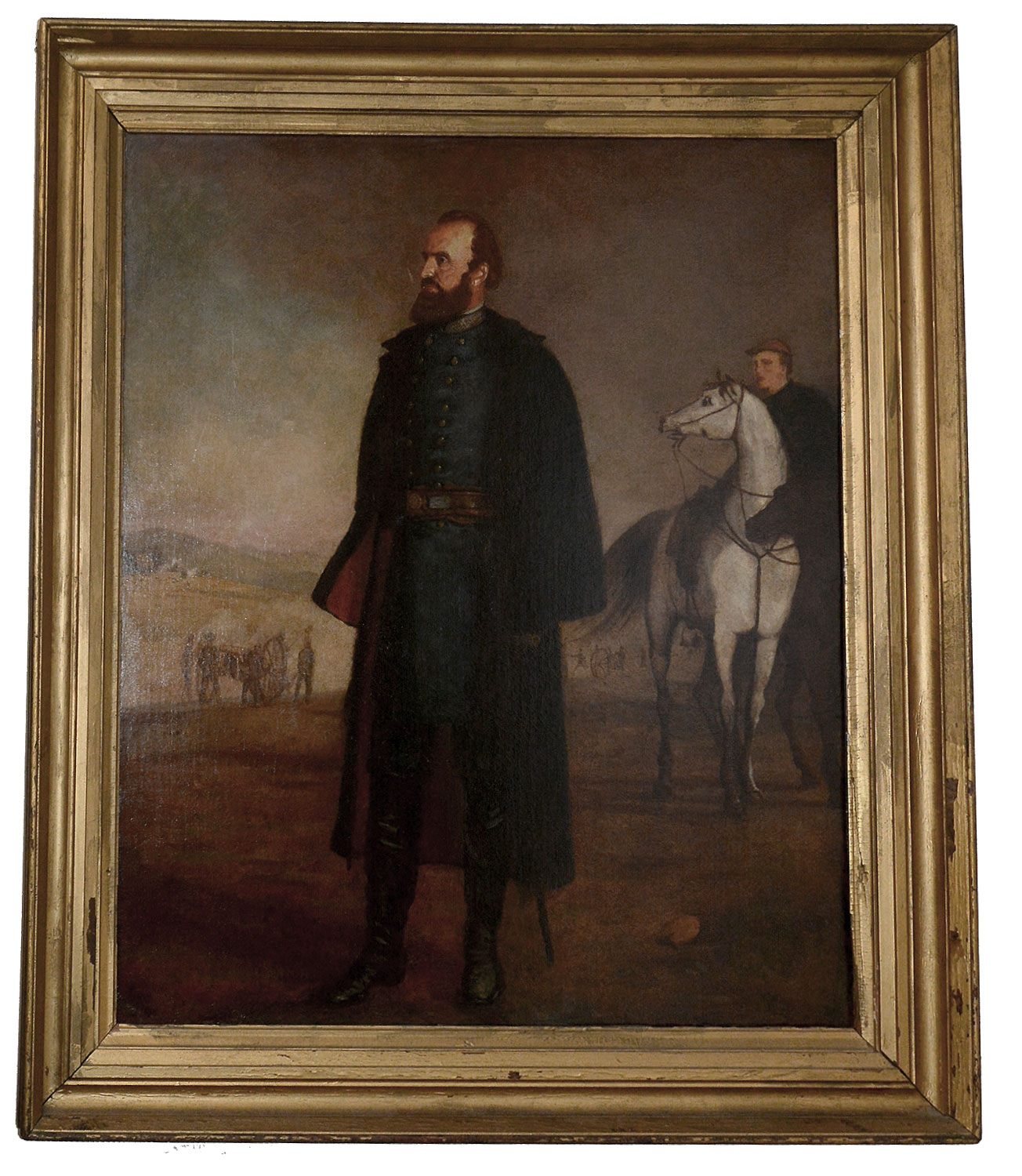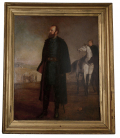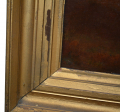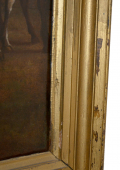site search
online catalog
STONEWALL JACKSON BY NOTED FREDERICKSBURG VIRGINIA ARTIST JOHN ADAMS ELDER (1833-1895)

$24,500.00
Quantity Available: 1
Item Code: 846-573
Shipping: Determined by Method & Location of buyer
To Order:
Call 717-334-0347,
Fax 717-334-5016, or E-mail
Dating about 1870, this portrait shows Jackson full-standing in the foreground while a mounted orderly in the right middle-ground tries to manage both his and Jackson’s horses as Confederate artillery crews behind them engage an enemy in the distance. Puffs of smoke from enemy guns or their own shell bursts show near some trees and a building on a distant hillside, with a low mountain range in the background. Jackson wears a dark caped overcoat partially open to show a red lining and his gray Confederate general’s uniform. His wears a sword belt and sash, but the only warlike attribute is the end of a scabbard showing below his overcoat, next to his tall riding boots. He gazes off to the viewer’s left, calm and confident in his strategic mastery of the terrain behind him and that his men are well positioned for their fighting.
Elder’s portrait owes something to John Trumbull’s 1792 painting of Washington before the Battle of Trenton and its many print reproductions where Washington stands calm and imperturbable in the foreground, holding a telescope in token of his strategic sense, as an orderly struggles to manage his fiery white warhorse in the background, while a cannon barrel and soldiers in the smoke of battle are visible lower down. The influence seems particularly evident in Elder’s decision to change the color of Jackson’s famous mount “Little Sorrel” to white.
A more immediate inspiration was certainly James Reeve Stuart’s more constrained portrait of Jackson, dated to 1869, where he similarly stands in the foreground with an artillery crew in action in the lower left background and another crew more dimly visible to the right. In that portrait what appears to be more a mounted aide than an orderly leads up a second dark horse in the intermediate ground on the right. Both artists certainly relied on the famous Minnis and Cowell April 1863 photograph of Jackson, or its many reproductions, for Jackson’s features, but we notice some similarities as well to Adalbert Volk’s late 1862 etching of Jackson standing serenely on an elevation with a vast landscape stretching off in the distance, perhaps suggesting his masterful Valley Campaign of 1862. Elder and Stuart both introduce martial elements into a romanticized historical portrait, part of both the Lost Cause mythology of the postwar south and, in Elder’s case at least, perhaps his own experience. He seems to have acted as a volunteer aide to W.H. Caskie, commander of a Virginia light artillery battery. In addition to the cannon behind Jackson, we note Elder has added the red kepi of an artilleryman to the orderly handling the horses on the right.
Elder, born in 1833, was a Fredericksburg, VA, native. He studied art under Daniel Huntington, best known for his portraits, but praised also for his landscapes, and also spent time abroad with Emmanuel Leutze, best known for “Washington Crossing the Delaware” and “Washington Rallying the Troops at Monmouth.” Elder reportedly studied for five years in Dusseldorff during Leutze’s sojourn there in the 1850s. He returned to the U.S. to stay briefly in New York, but settled back in Fredericksburg, where he kept a studio. He seems to have moved his studio to Richmond about 1858.
He was reputedly back in Fredericksburg to witness the bombardment of the city in December 1862 and in response joined the Hampden Artillery, commanded by W.H. Caskie, on Dec. 12, 1862, being detailed as an aide to Caskie on Dec. 15. A mid-May 1863 letter, however, indicates he was then employed as a draughtsman at the Richmond Arsenal and an article about a 2007-2008 exhibition of Elder’s work says he was an artist for “Southern Punch” at the beginning of the war, but it seems that magazine did not begin publication until August 1863. The same article maintains he was a “member of Caskie’s battery” in 1864 when he did a topographical sketch of the Crater battleground, but this seems to have been in preparation for a painting of the battle destroyed in the Richmond fires of April 1865, indicating wartime artistic work and again creating questions about his exact military service. We note that he has no compiled military service record file.
His postwar work was dominated by portraits of Confederate heroes that included no fewer than eight portraits of Robert E. Lee, commissioned by the cities of Savannah, Atlanta, and others. His subjects also included prominent politicians, judges, and other leaders, battle scenes (including a new version of the Battle of the Crater, purchased by Gen. William Mahone,) and romanticized scenes of Virginia life, as well as wartime episodes such as “The Scout’s Return.” But, he also caught some of the war’s cost in a pensive former Confederate soldier in a devasted landscape titled “Appomattox,” though he certainly concentrated on notions of nobility or courage even in defeat with paintings of Lee leaving Appomattox, and a later interest in portraying “Custer’s Last Charge.” Elder’s pursuit of a life portrait of Jefferson Davis in 1887 cost him his health after contracting malaria while visiting Davis in Mississippi. He closed his Richmond studio and returned to Fredericksburg, where he died in 1895.
The painting measures about 34 1/2” by 29 3/4” and 42 1/2" by 37 1/2” framed and displays very well, having undergone some conservation in cleaning, lining and inpainting. It is by a well known southern artist, and emblematic of his most famous work commemorating Confederate figures who had attained legendary status in southern households, like Lee in losing none of their nobility in defeat, or in death, like Jackson. [sr][ph:L]
Extra shipping charge required.
~~~~~~~~~~~~~~~~~~~~~~~~~~~~~~~~~~~
THIS ITEM, AS WITH ALL OTHER ITEMS AVAILABLE ON OUR WEB SITE,
MAY BE PURCHASED THROUGH OUR LAYAWAY PROGRAM.
CLICK HERE FOR OUR POLICIES AND TERMS.
THANK YOU!
Inquire About STONEWALL JACKSON BY NOTED FREDERICKSBURG VIRGINIA ARTIST JOHN ADAMS ELDER (1833-1895)
For inquiries, please email us at [email protected]
Most Popular
Historical Firearms Stolen From The National Civil War Museum In Harrisburg, Pa »
Theft From Gravesite Of Gen. John Reynolds »
Selection Of Unframed Prints By Don Troiani »
Fine Condition Brass Infantry Bugle Insignia »
British Imported, Confederate Used Bayonet »
Scarce New Model 1865 Sharps Still In Percussion Near Factory New »
featured item
RARE CONFEDERATE “THREE SQUARE” SOCKET BAYONET
This is an excavated example of a Confederate-made musket socket bayonet. Measuring 21” overall with a 2.75” socket. This was made for an early .69 caliber musket with a bayonet lug mounted on the bottom of the barrel; as the bridge is on the… (2022-459). Learn More »
site search
Upcoming Events
May 16 - 18: N-SSA Spring Nationals, Fort Shenandoah, Winchester, VA Learn More »








